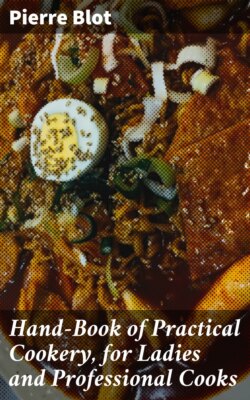Читать книгу Hand-Book of Practical Cookery, for Ladies and Professional Cooks - Pierre Blot - Страница 74
На сайте Литреса книга снята с продажи.
SPICES.
ОглавлениеThe cooks of this country generally have a queer idea of what they call French cookery and French spices.
Some honestly believe that to make a French dish a great deal of pepper and other strong seasonings must be put in.
Many other persons, who have not been in Europe, really believe also, that French cookery is what is called highly-seasoned. There never was a greater mistake.
If French cooks use several kinds of spices, and may-be more than American cooks, they are not the same; or if some are the same, such as pepper, they use them in much smaller proportions.
They generally use thyme, parsley, bay-leaf, chervil, tarragon, etc., which are aromatic; but never use (in this climate) ginger, curry, cayenne pepper, pimento, catsups, variegated colored pickles made with pyroligneous acids, etc., and which are very exciting and irritating.
Some of our readers may naturally ask: How is it that French cookery is believed by many to be the contrary of what it really is?
Because every eating-house, of no matter what size, pretends to be a first-rate one or a fashionable one—and to be first-rate or fashionable must, as a matter of course, have French cooks, or at least cook French dishes.
You enter the place, ask for a French dish; or, ask if you can have such a dish, à la Française?
You are politely and emphatically answered in the affirmative; and very often the polite waiter says that a French cook presides in the kitchen.
Result!—the cook, be he from the Green Isle or of African descent, receiving the order to prepare a French dish, puts a handful of pepper in the already too much peppered, old-fashioned prepared dish, and sends it to the confident customer as a genuine French dish.
Said customer never asks a second time for a French dish, and pronounces French cookery to be—abominable!
